| top |
acoustic steelguitars
|
 |
hawaiian guitar
example : OAHU,
bought via internet from
Dan Yablonka, 2011 |
| L=930 B=340 H=100mm
scale = 610mm |
|
hawaiian medley |
|
steelguitar rag |
|
hawaiian
guitar
In the 1890's people on Hawaii started playing
the guitar in a different way, laying it flat on their
lap, and not fingering chords, but shortening the strings with
a straight (steel) object. As they already used an open tuning
on a guitar, it was not difficult to play like this.
In the early 1910's Hawaiian music became a craze in USA and with
it the hawaiian guitar became very popular, together
with the acompanying small guitar: the ukulele
(see AmericaNorth).
In fact any guitar can be used as an hawaiian
guitar (although often it was a kind of spanish guitar
model) as long as it has steel strings, which are tuned to an
open tuning. The main difference with a normal guitar
is a slightly raised nut, so the sliding steel does not touch
the frets. Some instruments were made of the beautiful koa wood.
| As
you play the instrument horizontally, the round neck was not
necessary, so often the instrument got a square neck - which
was also good to avoid warping due to the high action of the
steel strings.
The tuning is usually open, like
:
E A e a c#' e' or : A c# e a c#' e' or : G B d g b d'. |
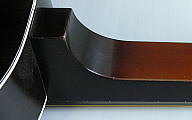 |
The sound of the (acoustic)
hawaiian guitar is not so strong, compared with resophonic
guitars.
Note that nowadays on the Hawaii islands this instrument
is hardly used anymore : they play the slack key guitar
(a normal guitar in open tuning). |
|
| top |
|
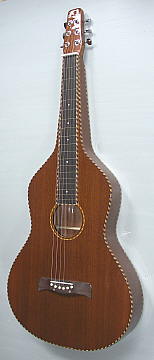 |
Weissenborn guitar
example :
bought from Bediaz
via eBay 2013 |
| L=960 B=400 H=75mm
scale = 625mm |
| |
|
weissenborn
guitar
During the craze of the hawaiian music, the USA
maker Weissenborn designed a special type of hawaiian guitar.
As an hawaiian guitar does not need a
roundneck, his design has a square hollow neck, as an extention
of the body, in an attempt to increase the sound volume. His instruments
became rather popular among hawaiian musicians.
Although many of his instruments were quite plain
(type nr.1), the usual decoration was a black/white rope binding
around the edge of the body and the fingerboard (type nr.4).
The overall construction is like a normal guitar, but
the (metal) frets are replaced by just inlay lines for orientation.
The sound is not so strong,
compared with resophonic guitars.
|
|
| |
|
| top
|
resophonic
guitars |
|
A
resophonic or resonator guitar is different from a
resonator banjo, where the name refers to the round wooden
back to increase the sound volume. Inside the body of a resonator
guitar is a special thin aluminium cone to get more volume.
|
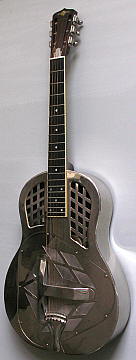 |
tricone
example :
Continental, bought 2000 |
| L=960 B=360 H=80mm
scale = 645mm |
| |
|
tricone
A tricone was the first type of resonator
guitar. It was made in the 1930's by the National factory
in USA, of thin shiny metal (nickel plated bellbrass), in a stylish
art deco design. Tricones were made with different amounts
of decoration : from style 1, which was plain, up to style 4,
which had chrysantimums etched around the front, sides and back.
Inside the (lower half of the) body are 3 round
aluminium cones, on which the bridge rests via a tripod. Reason
for 3 small cones was that they could not make the aluminium cones
big enough. The 3 cones (with the opening to the back) are covered
with diamond shaped grilles. In the top half of the body are 2
large sound holes, covered with thin metal strips (usually part
of the body). Pity the neck end does not follow the lines of the
grills, but stops squarely.
The tricone was popular with both hawaiian
players (they played it flat on the lap with a steel) as with
(Delta-)bluesplayers (they played it normal, often with a bottleneck).
The guitar therefore was available with either a square neck or
a round neck (see also dobro).
You have to play quite strongly to get the proper
sound out of it, so the use of finger picks is necessary.
For lots of information about these instruments
see Nationalguitars.
Around 2000 the bellbrass tricones became
popular again, but the original factories did not have the moulds
anymore to make them. So small firms started making copies, and
finally the National and Dobro factories started up their own
production lines again. The Continental is a small workshop in
Germany. |
|
| top |
|
 |
triolian
example : Johnson, bought from Thomann, 2011 |
| L=1000 B=365 H=80mm
scale = 650mm |
| |
|
triolian
The triolian is a type of resonator
guitar made in the 1930's by the National factory in USA,
when they managed to produce larger cones.
Although a number was made with a wooden body, it usually has
a multi-hued painted steel body. In spite of the name, this type
has only one (large) cone. Its opening is to the back, with a
small round wooden "bisquit" on the front, on which
the bridge rests.
The round cover plate has a decoration of 9 diamonds of pierced
holes. On the top of the body are two stylised f-holes, like on
a violin. Often the body is decorated with stencilled
pictures of Hawaiian scenes.
The duolian
is a cheaper version of this type of resonator guitar,
also made by National.
The trojan (or El Trovador)
is another similar resonator guitar, but with a wooden
body.
A more expensive version was the style 0,
which had a bell-brass body and Hawaiian scene etchings.
Later cover plates had a so-called "chickenfeet"
design (see picture right). |
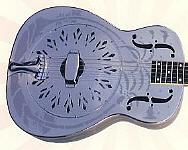 |
The triolian sounds a bit like a banjo,
and it is quite loud. It is used both for bottle neck playing
and for normal picking.
For lots of information about these instruments
see Nationalguitars.
|
|
| top |
|
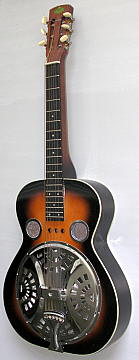 |
dobro
example :
Regal squareneck,
bought 1998 |
| L=970 B=380 H=85mm
scale = 625mm |
|
original style |
|
Jerry Douglas style |
|
dobro
The dobro is a type of resonator guitar
which was designed in the 1930's by the Dopyera
Brothers in USA - hence the name "dobro".
The construction of the cone is different from the earlier made
tricones and triolians (see above) made by National.
The cone of the dobro has the opening
to the front, with a spider-like construction resting on the edge
of the cone, and the bridge resting on the "spider".
The cone is covered by a round metal plate with many cut-outs
in 4 halfround patterns. Above this big cover plate are two separate
round soundholes, which are covered with small grills. Between
those grills are 3 small open soundholes.
As most players play the dobro laying
flat (with a steel), it often has a square neck, and a high nut
to get the strings high off the fingerboard. The tuning machines
are often turned around (to the front) to make tuning easier.
However, some dobros may be made with a normal halfround
guitar neck and a low nut (and real frets), to be played like
an ordinary guitar.
Tuning is nowadays often : G B d g b d'.
The sound of a dobro is a bit nasal, and
highly recognisable. The dobro is now mainly used in
Bluegrass Music, and played with a steel.
For more information about dobros see
: dobroguitar. |
|
| top |
|
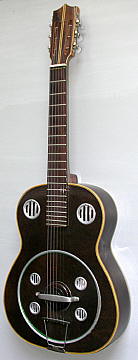 |
DelVecchio
example :
Del Vecchio, bought from ABCMusical.com, Brazil 2003 |
| L=1000 B=370 H=100mm
scale = 640mm |
|
Chet Atkins |
|
jazz |
|
delvecchio
/ Dinãmico
In Brazil the guitar factory of DelVecchio
(or "Del Vecchio") made a local version of a resonator
guitar. This instrument was officially called the "Dinãmico",
but players often refer to it just by the factory name. The factory
in São Paulo had stopped (officially) making these instruments,
but on its website they are still mentioned : DelVecchio.
Nowadays they are only custom made by luthiers.
This instrument is quite rare outside Brazil, but
a famous player like Chet Atkins played on one. The fretting was
usually not very well done, so they were known to be slightly
out of tune on some notes.
Inside a DelVecchio guitar is a dobro-type
aluminium cone with a wooden cylinder on which the bridge rests.
The cone is covered with a round thin wooden plate, in which usually
5 small round soundholes, covered with metal grilles. Some instruments
have 6 holes and up to 10 can be found. The type of the grilles
varies, and sometimes they are made of plastic, or just a V-shape.
In the top of the body are two (usually bigger) soundholes with
similar grilles. Often beautiful Brazilian woods are used for
the body.
Note that this resonator guitar is usually
not played with a steel or bottleneck, but as a normal guitar.
The sound is usually quite "dark" (not at all like the
sound of Chet Atkins' instrument), but marvellous for single-note
jazz picking.
A similar looking guitar, but with 5 double
metal string courses is called a viola caipira or
viola sertaneja and used for Brazilian country music. For
some years the Brazilian factory Rozini made both 6-string and
5-course versions under the name "Vibrante". Now these
instruments are only custom made and known as "viola dinamica"
(see Brazil).
A similar type resonator guitar is also
made by McGill.
The example instrument was
specially made for me. The wood is quite dark, making the instrument
looks like it is made of bakelite. Probably there was a shortage
of grilles at the time of building, as the 5th hole (on the top
of the circle) is missing. |
|
| top |
electric steelguitars |
 |
frypan lapsteel guitar
example :
copy made by
JanvanderDonck,
bought second hand, Holland 2011 |
L=790 B=180 H=40mm
scale = 620mm |
|
|
|
frypan
Probably the earliest production electric guitar
was was not a guitar, but a 6-string steel guitar,
made in the 1930's by Rickenbacher from solid aluminium. As the
shape (and material) resembled a fry(ing) pan, it got its nickname.
It was played laying on the lap, that is why these steelguitars
are often called lap steels.
The
entire body is made from a solid piece of aluminium, making
it very heavy (4 kg), but giving it a lot of sustain.
It has a horseshoe pickup, by which the strings go directly
through the magnetic field, to the bridge at the end of
the body.
|
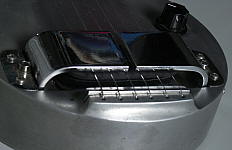 |
The buttons of the tuning machines face upwards,
for ease of tuning.
There are very many tunings in use for steelguitars,
but a wellknown one is
the C6 tuning : c e g a c' e'.
Since the 1990's Jerry Byrd (and others) designed
a remake of the aluminium frypan, with some models made
with 8 strings. See for more info on this frypan : Fuzzy.
|
|
| top |
|
 |
lapsteel guitar
example : Japanese lapsteel Diamond, bought in Rotterdam, 1970 |
L=850 H=140 B=40mm
scale = 525mm |
|
hawaiian style |
|
more necks |
|
| (lap) steel guitar
The lapsteel (always electric) is usually
just a solid big plank of wood with strings on it (6, 7, 8 and
sometimes even 10) with some decoration to show the "frets"
for orientation. The sound comes via the electric amplifier.
The shape is usually rectangular, but you can also
find vague (solid body) guitar shapes, or an art-deco type body.
| Often the steel
guitars are not really played on the lap, but they are
mounted on 3 or more legs. And then sometimes 2, 3 or even
4 steel guitars are joined together - each one tuned in a
different tuning, so the player can easily change from one
tuning to another (although only rarely halfway during a song). |
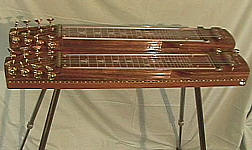 |
Not always all the notes of a chord are in the
straight line of the steel, so the steel often has to be slanted
(both ways) to get the proper notes on different strings. It demands
quite a lot of practice to get those notes in tune...
Another important part of the lapsteel
(and even more so for the pedalsteel guitar)
is the volume pedal. By lowering the volume at the moment of picking
the strings, and then - when the sound of the strings decreases
- the volume pedal is pressed in such a way, that the resulting
sound stays on a more or less even level - often giving the impression
of an organ.
For more information see Brad's
Steel.
Note that the example has a built-in amplifier
for use during practising. |
|
| top |
|
| top |
dulcimers |
 |
épinette des vosges
example :
bought via eBay, 2007 |
L=850 B=120 H=45mm
scale = 640mm |
|
|
 |
citera
example : bought in Budapest, 1985 |
L=810 B=110 H=50mm
scale = 660mm
bourdons :
440/330/220mm |
|
|
 |
mountain dulcimer
example : bought 1980 |
L=830 B=155 H=40mm
scale = 640mm |
|
with roller |
|
with fingers |
|
In
folk music (both in Europe and USA) the dulcimer is used, which
has a playing technique which looks quite similar to that of steel
guitars. However it is always fretted, and usually only played
acoustic, so unamplified.
A dulcimer or hummel is basically a long wooden soundbox
with on top a fingerboard with frets and some strings. The frets are
usually diatonic (not chromatic), so one can often play in just one
mode / scale. The melody string is often double.
 |
The
dulcimer is played laying down on a table or on the lap,
with the tuners on the left side.
The right hand often strums all the strings together, while with
the left hand usually only the first string (nearest the player)
is fingered. This fingering is done with a round bit of wood (a
"noter") and for fun even the end of a wooden spoon can
be used.
The other strings are just bourdon strings : they are usually tuned
to the root of the scale and only played open.
Strumming can be with a finger or with a plectrum (or very traditional
: with the back of a goose feather). |
The European dulcimers usually have a fingerboard
only under the melody strings.
The mountain dulcimers have ALL the strings
above the raised fingerboard. Some players can manage to play "upside
down guitar" by pressing down the strings on the fingerboard with
separate fingers of the left hand, so actually playing chords.
The dulcimer is known in different countries under different
names, which does not always reflect a special shape of the sound box.
Most instruments are hand-made by local craftsmen, so may differ quite
a lot.
| France |
épinette
des vosges *) |
| Holland/Belgium |
hommel / hummel *) |
| Norway |
langeleik *) |
| Germany |
scheitholt *), hummel
*), kratzzither |
| Hungary |
citera |
| USA |
Appalachian or mountain
dulcimer |
*) these instruments all look very similar.
The number of melody strings can vary (1 to 3), but it
is the number of bourdon strings that will greatly differ, like on the
Hungarian cetera.
Strings on the
examples :
France : épinette
des vosges
2 melody strings, 3 bourdons
Hungary : citera
5 melody strings, 3 long bourdons, 3x2 shorter bourdons
USA : (Appallachian)
dulcimer
2 melody strings, 2 bourdons |
On some East-European
instruments there is a second row of frets between the main frets,
giving the full chromatic range (like on the citera).
For some information on the dulcimer see
dulcimers,
and for lots of different German instruments, see Museum
(in German). And about the hummel see Ulricus
(in German) |

(from website Folknotes) |

(from website Folknotes) |
Left :
the USA mountain
dulcimers often have the shape of an ellips (or
teardrop) or a figure eight (or hourglass).
The example is a triangular dulcimer.
|
| |
right :
German kratzzither
(usually a dulcimer with a bulging soundbox, and
raised fingerboard)
(picture from eBay)
|
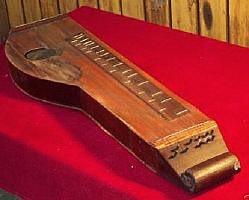 |
|











